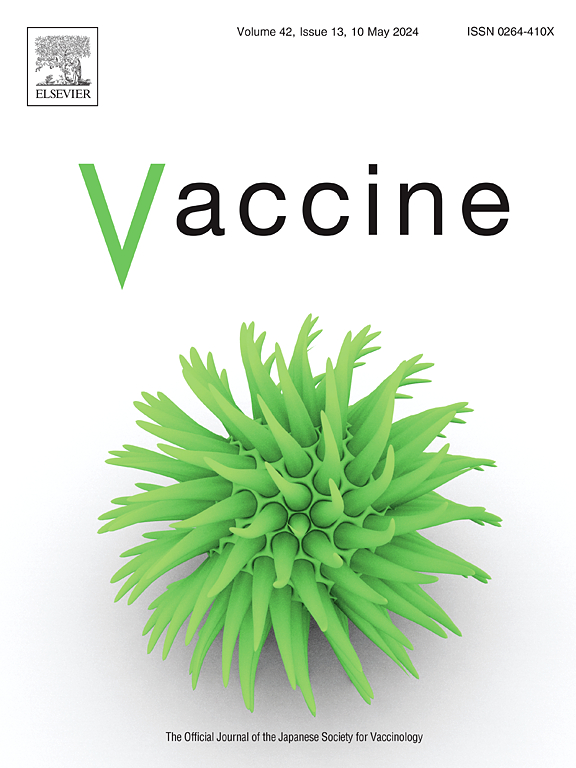Understanding occupational and attitudinal factors influencing UK healthcare worker decisions for COVID-19 and influenza vaccination: A cross-sectional survey within SIREN
IF 4.5
3区 医学
Q2 IMMUNOLOGY
引用次数: 0
Abstract
Background
Seasonal vaccination of healthcare workers (HCWs) against COVID-19 and influenza has been recommended to protect patients and the workforce against Winter pressures. We aimed to investigate demographic, occupational, accessibility and tolerability factors associated with COVID-19 and influenza vaccination among HCWs within the SIREN study cohort in 2023/24.
Methods
We conducted a cross-sectional survey between 29 February-22 March 2024 within SIREN, a prospective HCW cohort across the UK. Adjusted odds ratios (aOR) and 95 % confidence intervals (CI) from a multivariable regression analysis were used to identify factors associated with vaccination. Proportions were calculated to describe the rationale for receiving/not receiving seasonal vaccines.
Results
A total of 5357/33,007 (16.2 %) SIREN participants completed the survey. 66.7 % (3572/5357) received both vaccines, 2.4 % (129/5357) COVID-19 only, 12.4 % (662/5357) influenza only, and 18.3 % (979/5357) neither. Participants were more likely to receive any vaccine if they were over 65 years (aOR 2.73, 95 % CI: 1.64–4.55), a doctor (aOR 2.28, 95 % CI: 1.70–3.05) or had a chronic respiratory condition (aOR 1.52, 95 % CI: 1.20–1.92). Participants of Black ethnicity were less likely to be vaccinated (aOR 0.42, 95 % CI: 0.27–0.66). The top reason for vaccination was to protect oneself (81.6 %). Concern about long-term side effects was the main reason for not getting vaccinated among those who did not receive the COVID-19 vaccine (30.1 %).
Discussion
We observed differences in uptake and attitudes towards seasonal vaccines among UK HCWs within the SIREN cohort. Differences in demographic characteristics, occupation and attitudes varied by vaccine type and this should be considered when planning seasonal vaccination programmes to protect the health workforce.
了解影响英国医护人员COVID-19和流感疫苗接种决策的职业和态度因素:SIREN的横断面调查
建议卫生保健工作者(HCWs)季节性接种COVID-19和流感疫苗,以保护患者和工作人员免受冬季压力。我们的目的是在2023/24年的SIREN研究队列中调查与COVID-19和流感疫苗接种相关的人口统计学、职业、可及性和耐受性因素。方法:我们于2024年2月29日至3月22日在英国的前瞻性HCW队列SIREN中进行了横断面调查。采用多变量回归分析的校正优势比(aOR)和95%置信区间(CI)来确定与疫苗接种相关的因素。计算比例是为了说明接受/不接受季节性疫苗的理由。结果共5357/33,007(16.2%)名SIREN参与者完成了调查。66.7%(3572/5357)接种了两种疫苗,2.4%(129/5357)仅接种了COVID-19疫苗,12.4%(662/5357)仅接种了流感疫苗,18.3%(979/5357)均未接种。如果参与者年龄超过65岁(aOR 2.73, 95% CI: 1.64-4.55)、是医生(aOR 2.28, 95% CI: 1.70-3.05)或患有慢性呼吸系统疾病(aOR 1.52, 95% CI: 1.20-1.92),则更有可能接种任何疫苗。黑人受试者接种疫苗的可能性较低(aOR 0.42, 95% CI: 0.27-0.66)。接种疫苗的首要原因是保护自己(81.6%)。没有接种新冠疫苗的人中,担心长期副作用是不接种疫苗的主要原因(30.1%)。我们观察到在SIREN队列中,英国卫生保健工作者对季节性疫苗的吸收和态度存在差异。人口特征、职业和态度的差异因疫苗类型而异,在规划季节性疫苗接种规划以保护卫生工作人员时应考虑到这一点。
本文章由计算机程序翻译,如有差异,请以英文原文为准。
求助全文
约1分钟内获得全文
求助全文
来源期刊

Vaccine
医学-免疫学
CiteScore
8.70
自引率
5.50%
发文量
992
审稿时长
131 days
期刊介绍:
Vaccine is unique in publishing the highest quality science across all disciplines relevant to the field of vaccinology - all original article submissions across basic and clinical research, vaccine manufacturing, history, public policy, behavioral science and ethics, social sciences, safety, and many other related areas are welcomed. The submission categories as given in the Guide for Authors indicate where we receive the most papers. Papers outside these major areas are also welcome and authors are encouraged to contact us with specific questions.
 求助内容:
求助内容: 应助结果提醒方式:
应助结果提醒方式:


